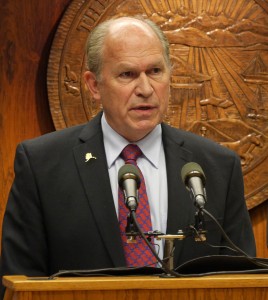
When Gov. Bill Walker held a press conference in February to announce changes coming for the Alaska LNG gas line project, he left most observers scratching their heads.
Standing beside representatives from the state’s three partners – ExxonMobil, BP, and ConocoPhillips — Walker said he hoped to release more details in March.
Today, Walker said he doesn’t expect to have any update for the public before April, as negotiations between the state and its partners continue.
“Things seem to take a bit longer than everyone anticipates,” Walker said. “When we had our press conference …we thought there’d be something out this month, and it doesn’t look like that’s going to happen.”
In February, the governor and oil companies said they were “exploring options” to keep the project going at a time of low oil and gas prices. As for what, exactly, that means – it’s still not clear.
“We’re just analyzing what the options are, and evaluating the pros and cons of each from a structural standpoint,” Walker said. “That has not concluded yet, so when it does, we’ll have something to report.”
The original goal was to hammer out agreements between the state and companies for lawmakers to vote on this spring — and to put a constitutional amendment on the ballot this fall, to lock in tax rates for the pipeline.
The administration believed that amendment would be necessary before the partners could decide whether to enter the next phase of the project (called FEED, or Front End Engineering and Design) in 2017.
But slow negotiations, crashing oil prices, and a weak natural gas market have combined to throw that timeline into question.
Walker said today it’s clear there will be no amendment vote this year (constitutional amendments must appear on a general election ballot, meaning the next opportunity would be 2018). But, he said, he believes there’s a way forward without it — and he is adamant the project must still aim to come online, as planned, in the mid-2020s.
“It’s a good target time in the market for this to come online,” Walker said. “That part has not changed.”
The question is whether that’s still realistic, especially for a so-called “gigaproject” expected to cost $45-$65 billion.
Larry Persily, an adviser to the Kenai Peninsula Borough, just returned from a conference of liquified natural gas producers and buyers in Singapore.
“The main takeaway is the market has gotten worse in the past year, not better,” he said.
With new projects coming online around the world, there is too much supply chasing too few customers, driving down natural gas prices. Analysts expect the market will need new suppliers in the middle of the next decade, Persily said, but there are a lot of projects competing to meet that need. Alaska can only compete if it can keep costs very low.
That may be what the state and its partners are trying to figure out – for now, behind closed doors.
[fbcomments url=”http://www.alaskapublic.com/wordpress-plugins/facebook-comments/” width=”375″ count=”off” num=”3″ countmsg=”wonderful comments!”]
Rachel Waldholz covers energy and the environment for Alaska's Energy Desk, a collaboration between Alaska Public Media, KTOO in Juneau and KUCB in Unalaska. Before coming to Anchorage, she spent two years reporting for Raven Radio in Sitka. Rachel studied documentary production at the UC Berkeley Graduate School of Journalism, and her short film, A Confused War won several awards. Her work has appeared on Morning Edition, All Things Considered, and Marketplace, among other outlets.
rwaldholz (at) alaskapublic (dot) org | 907.550.8432 | About Rachel




